华罗庚中学优秀英语教案展示
- 格式:doc
- 大小:69.50 KB
- 文档页数:27
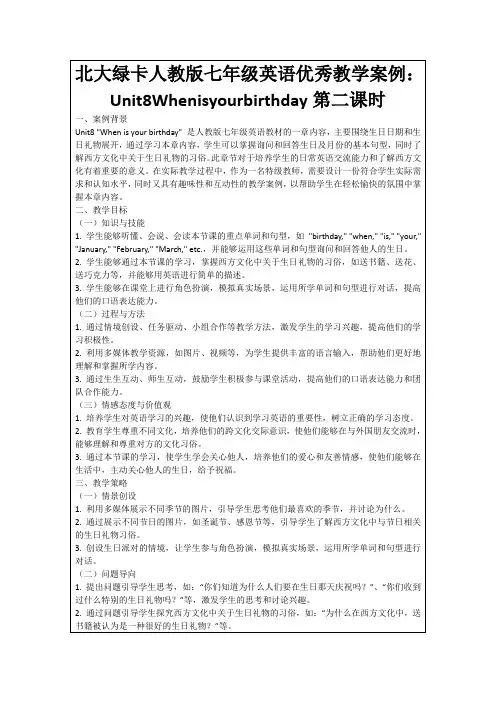
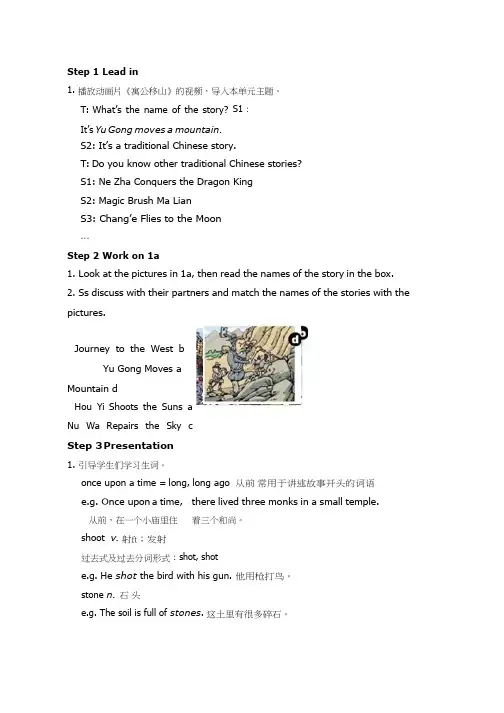
Step 1 Lead in1. 播放动画片《寓公移山》的视频,导入本单元主题。
T: What’s the name of the story? S1:It’s Yu Gong moves a mountain.S2: It’s a traditional Chinese story.T: Do you know other traditional Chinese stories?S1: Ne Zha Conquers the Dragon KingS2: Magic Brush Ma LianS3: Chang’e Flies to the Moon…Step 2 Work on 1a1.Look at the pictures in 1a, then read the names of the story in the box.2.Ss discuss with their partners and match the names of the stories with the pictures.Journey to the West bYu Gong Moves aMountain dHou Yi Shoots the Suns aNu Wa Repairs the Sky cStep 3 Presentation1.引导学生们学习生词。
once upon a time = long, long ago 从前常用于讲述故事开头的词语e.g. Once upon a time, there lived three monks in a small temple.从前,在一个小庙里住着三个和尚。
shoot v. 射ft;发射过去式及过去分词形式:shot, shote.g. He shot the bird with his gun. 他用枪打鸟。
stone n. 石头e.g. The soil is full of stones. 这土里有很多碎石。
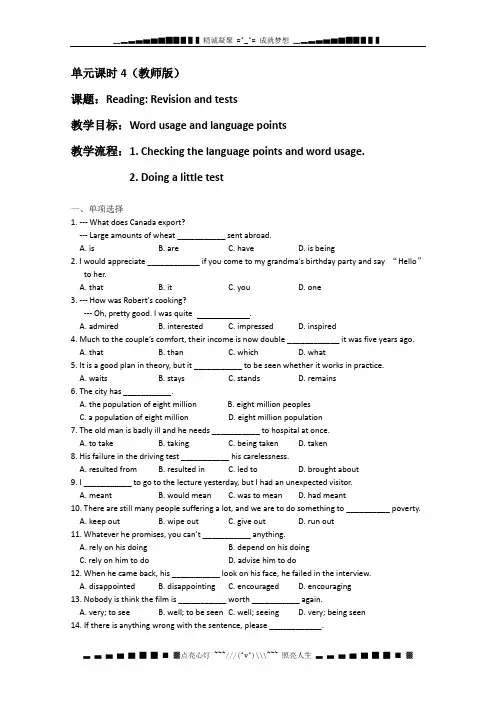
单元课时4(教师版)课题:Reading: Revision and tests教学目标:Word usage and language points教学流程:1. Checking the language points and word usage.2. Doing a little test一、单项选择1. --- What does Canada export?--- Large amounts of wheat ___________ sent abroad.A. isB. areC. haveD. is being2. I would appreciate ____________ if you come to my grandma’s birthday party and say “Hello”to her.A. thatB. itC. youD. one3. --- How was Robert's cooking?--- Oh, pretty good. I was quite .A. admiredB. interestedC. impressedD. inspired4. Much to the couple’s comfort, their income is now double ____________ it was five years ago.A. thatB. thanC. whichD. what5. It is a good plan in theory, but it ___________ to be seen whether it works in practice.A. waitsB. staysC. standsD. remains6. The city has ___________.A. the population of eight millionB. eight million peoplesC. a population of eight millionD. eight million population7. The old man is badly ill and he needs ___________ to hospital at once.A. to takeB. takingC. being takenD. taken8. His failure in the driving test ___________ his carelessness.A. resulted fromB. resulted inC. led toD. brought about9. I ___________ to go to the lecture yesterday, but I had an unexpected visitor.A. meantB. would meanC. was to meanD. had meant10. There are still many people suffering a lot, and we are to do something to __________ poverty.A. keep outB. wipe outC. give outD. run out11. Whatever he promises, you can’t ___________ anything.A. rely on his doingB. depend on his doingC. rely on him to doD. advise him to do12. When he came back, his ___________ look on his face, he failed in the interview.A. disappointedB. disappointingC. encouragedD. encouraging13. Nobody is think the film is ___________ worth ___________ again.A. very; to seeB. well; to be seenC. well; seeingD. very; being seen14. If there is anything wrong with the sentence, please ____________.A. pick it outB. pick it upC. pick itD. pick it on15. The one bedroom apartment ___________ its own bathroom and Internet access.A. is furnished forB. is supplied toC. is stocked withD. is offered with16. He is not a bit mean; instead he is always __________ to help anyone in trouble.A. possibleB. probableC. likelyD. willing17. Did you hear him ___________ the door when you passed by?A. lockingB. to lockC. having lockedD. lock18. Passengers are ___________ from using such electronic devices as mobile phones during take-off and landing.A. forbiddenB. encouragedC. prohibitedD. allowed19. When a discussion is under way, everybody is welcome to have the ___________ in class.A. floorB. timeC. chanceD. right20. What is ____________ is that try as they may, they can’t avoid the economic crisis.A. beneficialB. difficultC. effectiveD. obvious21. The young dancers looked so charming in their beautiful clothes that we took ______________pictures of them.A. many ofB. large amounts ofC. the number ofD. a good deal of22. There is still a long way to go to solve all the problems ____________ conservation of natural resources.A. concerningB. concernedC. concerning aboutD. concerned about23. Other simple information was recorded on the walls of caves and buildings in the _________ of pictures.A. wayB. meansC. formD. terms24. The Tower of London is ____ the Church tower.A. twice high thanB. two times as high asC. twice higher asD. three times the height of25. I want to leave now; I can’t ____ nothing useful here.A. stand to doB. stand doingC. stand being doneD. stand to be doing1-5 BBCDD 6-10 CBADB 11-15 CACAC 16-20 DDCAD 21-25 BACDB二、阅读理解When the population of the port town began to suffer from poisoning, the police came to find the cause of the poison. They thought someone was poisoning the people on purpose but no one knew how it was possible. Soon people took the position that the pork was poisoned. It was a popular food everyone ate and it could have possibly made everyone sick. Anyone who had possession of pork would throw it out. Even the poorest of the poor wouldn’t eat pork. Signs were posted on poles and letters were sent to everyone to warn people of the pork. Shortly afterwards, even policemen in high positions were also getting sick.Soon it became political and popular. Politicians rushed to the town to talk about politics and promised how they would find the solution if they were elected. Everyone was so sick that they didn’t care about politics. Everyone was in a position where he or she didn’t know what to do anymore. They went to the post office to mail posts out asking for help. The poor town didn’t know how to deal with the situation.One day, a well-known scientist from New York came to the town with a huge box containing many instruments and his possessions. He went to pools and the port and made measurements. Hewas quiet and polite. Then one day he made a speech at a newspaper meeting-room to announce his findings.“I am sorry to say your water supply is so heavily polluted; it is poisoned. I know who has been poisoning you all for such a long time. It is you who have been poisoning yourselves with pollution.A great deal of rubbish has been thrown into the water day after day. No one here has taken good care of the environment. It is no wonder all of you have been sick.” Shocked at the news, the people present were lost in thought.1. Which is the correct order of the facts described in the story?a. People suffered from poisoning.b. Politicians came to make promises.c. People began to realize the real cause.d. Pork was thrown away.e. The water there was polluted.f. A scientist came to check the water.A. e, a, d, b, f, cB. e, a, d, c, f, bC. a, e, b, d, c, fD. f, c, d, b, e, a2. What does the underlined phrase “ "took the position" mean in the passage?A. took the jobB. took the placeC. held the opinionD. made the suggestion3. Which of the following statements is correct?A. Everyone was so s ick of politics that they didn’t care about those politicians.B. According to the scientist from New York, not all the population in the town have taken goodcare of the environment.C. The reason why the people in the town got sick was that they ate the pork poisoned by theheavily polluted water.D. if the people in the town hadn’t polluted the water supply, they would not have suffered frompoisoning or sickness.4. After reading the passage, we can infer that ________A. politicians took every chance to make themselves electedB. pork was the main food of the people in the townC. people in the town were not well-educatedD. even some police officers were getting illADCA。
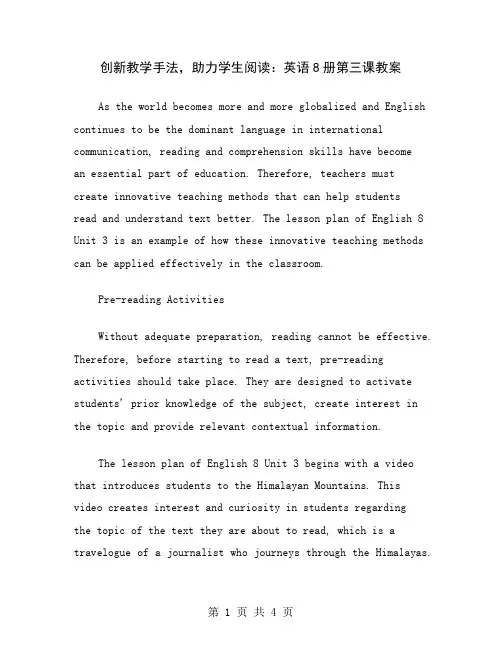
创新教学手法,助力学生阅读:英语8册第三课教案As the world becomes more and more globalized and English continues to be the dominant language in international communication, reading and comprehension skills have becomean essential part of education. Therefore, teachers mustcreate innovative teaching methods that can help studentsread and understand text better. The lesson plan of English 8 Unit 3 is an example of how these innovative teaching methods can be applied effectively in the classroom.Pre-reading ActivitiesWithout adequate preparation, reading cannot be effective. Therefore, before starting to read a text, pre-reading activities should take place. They are designed to activate students' prior knowledge of the subject, create interest in the topic and provide relevant contextual information.The lesson plan of English 8 Unit 3 begins with a video that introduces students to the Himalayan Mountains. Thisvideo creates interest and curiosity in students regardingthe topic of the text they are about to read, which is a travelogue of a journalist who journeys through the Himalayas.The teacher then presents photos of the highest peaks in the world, including Mount Everest, Cho Oyu, and K2, and provides information about their altitudes, locations, and interesting facts. This pre-reading activity helps students to become familiar with the subject and develop theirinterest in the topic.During-reading ActivitiesInnovative teaching methods like during-readingactivities can help students to comprehend better the meaning of a text. The lesson plan of English 8 Unit 3 uses several during-reading activities to enhance students' reading experiences such as discussion, vocabulary expansion, and comprehension.Firstly, the teacher divides the class into small groups to discuss the text's main ideas and points while reading, encouraging students to compare and contrast their thoughts and develop critical thinking skills. This discussionactivity helps students to actively engage with the text while gaining insight and understanding of challenging concepts.Secondly, to enhance students' vocabulary retention, the teacher uses word walls and interactive vocabulary games to reinforce new vocabulary introduced in the text. The game could be "I Spy" or "Scavenger Hunt," which requires students to find words that relate to the text and use context clues to understand their meaning. This fun activity enhances their vocabulary acquisition and provides them the necessary skills required to analyze and comprehend challenging texts.Finally, students participate in a reading quiz that tests their comprehension while reading and incentives to remember important points from the text. The quiz could be in the form of crossword puzzles or quizzes, and the students can play in groups or pairs.Post-reading ActivitiesThe last stage of a lesson plan for reading is the post-reading activities, where students demonstrate their understanding of what they have read and internalized.In the lesson plan of English 8 Unit 3, the post-reading activities involve students constructing their own travelogue based on their travels through the Himalayas. The teacherfirst models the process of writing a travelogue, then thestudents collaborate and create their own, applying the strategies and skills they learned from the pre-reading and during-reading activities.With innovative teaching methods like the lesson plan of English 8 Unit 3, teachers can help their students develop reading skills essential for their academic and professional life. These methods create engaging and fun approaches to learning, promoting self-directed learning and enhancing critical thinking skills at the same time.。
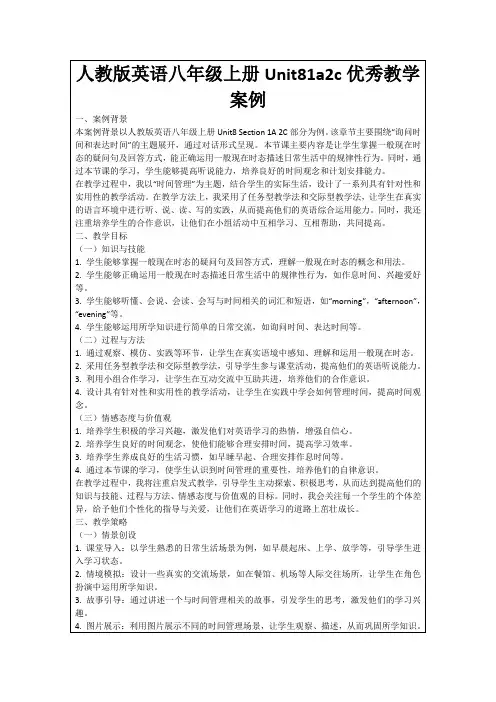
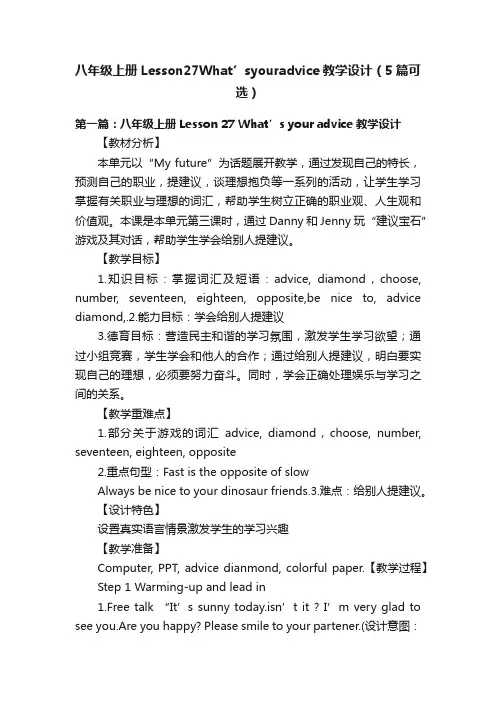
八年级上册Lesson27What’syouradvice教学设计(5篇可选)第一篇:八年级上册Lesson 27 What’s your advice教学设计【教材分析】本单元以“My future”为话题展开教学,通过发现自己的特长,预测自己的职业,提建议,谈理想抱负等一系列的活动,让学生学习掌握有关职业与理想的词汇,帮助学生树立正确的职业观、人生观和价值观。
本课是本单元第三课时,通过Danny和Jenny玩“建议宝石”游戏及其对话,帮助学生学会给别人提建议。
【教学目标】1.知识目标:掌握词汇及短语:advice, diamond,choose, number, seventeen, eighteen, opposite,be nice to, advice diamond,.2.能力目标:学会给别人提建议3.德育目标:营造民主和谐的学习氛围,激发学生学习欲望;通过小组竞赛,学生学会和他人的合作;通过给别人提建议,明白要实现自己的理想,必须要努力奋斗。
同时,学会正确处理娱乐与学习之间的关系。
【教学重难点】1.部分关于游戏的词汇advice, diamond,choose, number, seventeen, eighteen, opposite2.重点句型:Fast is the opposite of slowAlways be nice to your dinosaur friends.3.难点:给别人提建议。
【设计特色】设置真实语言情景激发学生的学习兴趣【教学准备】Computer, PPT, advice dianmond, colorful paper.【教学过程】Step 1 Warming-up and lead in1.Free talk “It’s sunny today.isn’t it ? I’m very glad to see you.Are you happy? Please smile to your partener.(设计意图:课前沟通,拉近与学生的心理距离,同时消除学生的紧张情绪)2.Play a picture game“Can you name their jobs?”Get students to Write down their jobs as fast as possible..(设计意图:通过游戏复习关于职业的词汇,激发学生的学习兴趣,同时帮助学生集中注意力)3.Ask“What do you want to do in the future ?”(设计意图:检查关于职业词汇的掌握情况,同时激发学生对美好未来的向往)Step 2 Presentation1.Ask “Do you want to know what you will do when you grow up ?”Let my “future diamond”tell you.Take out a paper diamond and tell Students it’s a “future diamond”, If you want to know your future job, just choose a color and a number.Then it will tell you the result.Encourage some students to play the game.(设计意图:借助“future diamond”,教学生如何玩“diamond”游戏,既是往新课的'引入,又活跃课堂气氛,激发学生的学习兴趣)2.Tell students having dream is very good ,but we must do something to achieve our dream.Show some dreams ,get student to give them some advice to achieve the dreams.Read the dreams and match them with the advice1)listen to your teacher carefully in class2)Practice basketball3)Take singing lessons4)Always be nice to your friends5)Work hard at schoolgo to a famous collegebe basketball playerbe a singerlearn English betterMake more friends(设计意图:通过匹配练习,帮助学生学会如何给建议;同时让学生明白:有行动才能实现梦想)Step 3 Listening practice.Listen and answerWhat colour does Jenny choose?(He chooses green.)What number does Jenny choose?(Fifty-one.)(设计意图:通过听力练习,训练学生有目的地捕捉所需信息的能力,同时在听的过程中,感受不同的语音语调,感受英语语言的美)Step 4 Reading1.Read the lesson and answer the questions(1).What colours does Danny’s advice diamond have ?(Green)(2)How many times does Jenny choose ?(Three times)(3).What advice does Jenny get at last ?Always be nice to your dinosaur friends(设计意图:指导学生运用Skimming, Scanning 的阅读策略,得到自己想要的相关信息)2.Get students to read aloud, and then read after the tape,imitate the intonation.(设计意图:通过朗读和跟读,模仿地道的英语语音语调,一方面激发学生的说英语的兴趣,另一方面,帮助学生掌握正确的发音方法)plete the short passage according to the lesson.Danny and Jenny are playing with their advice_______.Danny shows Jenny his diamond and asks Jenny ___ ____a colour.Jenny chooses_______,and then chooses the number _____.Under the number,It says”Fast is the _______of slow”.That’s not _____,but a fact.So ,they do it again.Jenny chooses green and a new______,It says”______you a wonderful future.”That’s a wish,not advice.Jenny has to pick ______number.It says”Always be ______toyour dinosaur friends.” That’s very good advice.(设计意图:以短文填空的形式训练学生对课文的复述,加深对课文的理解,同时学会怎样给别人建议)Step 5 SummaryShow the key words in the lesson on the screen, get students to read and make sure they know their meanings.advice diamond number oppositewish chooseseventeen eighteen(设计意图:归纳总结本课的重点词汇,加深印象)Step 6 Practice1.Fill in the blanks with the words in this lesson.(1).A: W_____you good luck.B:Thans phone n_____is 605-979-5532.You can call me if need help.(3).My teacher has given me some a_____about my future.(4.)Tomorrow is my fa ther’s birthday.I will c______a nice present for him.(设计意图:巩固本课的重点词汇)2.Let’s make our own advice diamondFirst, take out a piece of paper and fold it into an advice diamond.Next, Write some advice on it.Then, you can play with it.(设计意图:练习给别人建议,将说的内容落实到写上)Step 7 HomeworkMake your own advice diamond and play with it after class.But school work must come first.(设计意图:情感态度教育,学习是第一位的)【八年级上册Lesson 27 What’s your advice教学设计】相关文章:1.What’s your name教学反思2.Lesson 14 What‘s his name教案3.《what are your hobbies》教学反思4.外研社英语六上册《What`s your favourite festival?》教学反思5.Unit 1 What`s your name? 牛津小学1B 教案6.《What`s your favourite festival?》外研社英语六年级教学反思7.《What is your father-》教学反思8.《What is Your Number》教学反思范文9.《What’s this in English》教案设计反思第二篇:八年级历史上册教学设计八年级上册历史复习中国近代史(1840—1949)旧民主主义革命时期(1840—1919)第一单元列强的侵略和中国人民的抗争第1课中英鸦片战争(1840-1842)一、林则徐虎门销烟1、背景:①清朝后期已经走向衰败,英国成为世界上最先进,最强大的国家;②英国为了开辟市场,向中国走私鸦片,赚取中国白银毒害中国人民;③鸦片的输入带来巨大危害。
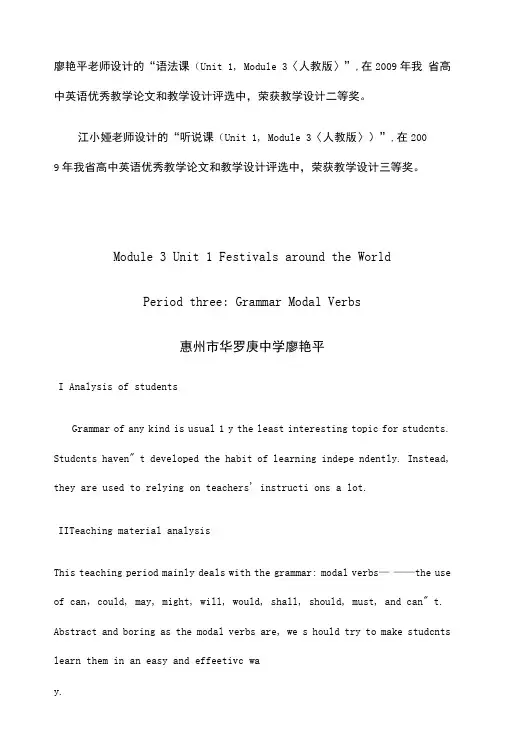
廖艳平老师设计的“语法课(Unit 1, Module 3〈人教版〉”,在2009年我省高中英语优秀教学论文和教学设计评选中,荣获教学设计二等奖。
江小娅老师设计的“听说课(Unit 1, Module 3〈人教版〉)”,在2009年我省高中英语优秀教学论文和教学设计评选中,荣获教学设计三等奖。
Module 3 Unit 1 Festivals around the WorldPeriod three: Grammar Modal Verbs惠州市华罗庚中学廖艳平I Analysis of studentsGrammar of any kind is usual 1 y the least interesting topic for studcnts. Studcnts haven" t developed the habit of learning indepe ndently. Instead, they are used to relying on teachers' instructi ons a lot.IITeaching material analysisThis teaching period mainly deals with the grammar: modal verbs———the use of can,could, may, might, will, would, shall, should, must, and can" t. Abstract and boring as the modal verbs are, we s hould try to make studcnts learn them in an easy and effeetivc way.Ill Teaching aims1.Knowledge aims:Get students to grasp the use of the modal verbs, discover the imp lied meanings of modal verbs used in sentences, such as permission, ability, possibility, request, promise, guessing and so on. And g et students to learn to use them in different situations with prop er modal verbs.2.Abilities aims:Cultivate students' ability to distinguish and discover the subt le implications that modal verbs carry in sentences and develop st udents' communicative ability by learning the use of modal verbs for making requests, giving advice, asking for permission, and so on.3.Emotional aims:Develop students,teamwork spirit and inspire students to be inte rested in grammar learning.IVTeaching key points and difficuIt points1.Teaching key pointsGet students to learn and master the use of the modal verbs in dis covering and practice, and enable students to learn how to use the m correctly indifferent contexts.2.Teaching difficuIt pointsGrammar rules are hard to remember, and grammar is a dull subject that some students are unwilling to learn it by heart.V Teaching and learning methodsTask-based Instruetion, Audio-visual Teaching MethodCooperative Learning and Active Exploration MethodUnder the guidance of learning by use it, make students thoroughly master the use of modal verbs in class while the teacher acts as a guide and director, leading students to learn grammar through al 1 kinds of activities and situations and make dialogues in pairs.VI Teaching aidsMulti-media computer, PPT, Blackboard, etc.VII T he time table of teaching procedures1. Revision and lead-in2. Presentation and discovering4. Production5. Homework VIH Teaching proceduresStep 1 Revision and lead-in1. Check up students' homework of the exercises on page 4.2. Let students listen to a song, I Want To Be With You, which con tains many modal verbs. Ask students to fill in the missing words in the lyrics ・ The lyrics are given in Appendix 1.3. Show some pictures to create certain contexts for students to r eview modal verbs. These sentences will activate students , knowle dge about modal verbs. Purpose: Bring up the topic of this period, modal verbs, and revie w related knowledge about them.Step 2 Presentation and discovering(5 minutes)(8 minutes)3. Practice(14 minutes)(12 minutes)(1 minute)1.Give out each student a sheet in which many sentences with moda 1 verbs are listed. Ask students to discuss in groups of four to w ork out how each of these modal verbs is being used in the situati ons. Tick the right answers. The sentences are given in Appendix2.Purpose: Introduce the usage of the modal verbs.2. A table will be shown to the students. Ask students to use the function words to explain the meaning of the modal verbs.Please refer to Appendix 3 for the table.Purpose: Improve students, ability to generalize.Step 3 PracticeActivity 1Do Exercise 2 on page 5. Students can discuss the answers with the ir partners. Purpose: Make students proficient in doing exercise with what theyhave Tearnt in the last step.Activity 2Present several pictures related to festivals around the world and let students complete the sentences according to the pictures wit h proper modalverbs.Purpose: Help students review some information about festivals aro und the world and cultivate the awareness of employing modal verbs in language production.Activity 3More exercises concerning modal verbs will be shown on the screen.The exercises are given in Appendix 3.Purpose: Check students, understanding of modal verbs.Step 4 ProductionStudcnts will be cncouragcd to make dialogues based on each of the given situations, using modal verbs. Practise in pairs and presen t the dialogue in class.1.You want to invite your foreign friend to com e China to spend the spring festival.You want to ask your mum for permission to go2.with your friends to the cinema.Purpose: Help students apply modal verbs to real situations and im prove their oral English skills.Step 5 Homework1- Finish off the Workbook exercises on P43.2.Create five sentences by using some of the modal verbs.Purpose: Consolidate their knowledge about modal verbs and practis e this grammar comprehensively.Teaching assessment1.In this lesson, I,ve learned ____________ •2.After the lesson I still have difficulty in _______________ .3.I feel ________ with my class per forma nee.A. very satisfiedB. satisfiedC. a lit tie sat isfiedD. not sat isfied at all4.I find I need to work harder in the following areas:A. learn before the lessonB. vocabularyC. writing abilityD. confidenee buildingE. working with othersAppendix 1I Want To Be With YouThere are things that must be doneThat are not yet begunThings that I must doWhen I want to be with youAlthough we might be far apartYou should be with me in my heartNo one else will doI just want to be with youI want to be with youCan,t you hear me?I need you near meI want to be with youI need you near me, my loveThe two of us must be one Mother of my sonNo one else will do1 just want to be with youT want to be with youCan you hear me?I need you near me1 want to be with youI ncccl you near me, my love Appendix 2She can sing that song in English, (ability / possibility) 1.2.I could not understand the lecture on the computer given b y Mr. Smith, (ability / guessing)3.You can borrow this useful book from the library, (possibi lity / permission)4.Can I ask you some questions about it? (advice / permissio n)5.She couldn" t/can' t be so stupid to do that, (request / g uessing)6.Could you speak a littie slowly? (euphemistic / past habi t)7.I may be busy from to morrow on. (ability / possibility)8.May I come in? (permission / guessing)9.Students must work hard at their study. (advice / permissi on)10.You must be tired after working so long, (guessing / predicti on)11.It mus t have rained las t night for it is so wet out side, (gue ssing / past habit)12.We should read English aloud every morning, (advice / agreement)13.This book should be published in two month at most, (predicti on / possibility)14.Would you tell me how to get to the shopping center? (guessin g / request)15.He would sit there for hours, doing nothing at all. (past hab it / ability) Appendix 3Appendix 41.一___ I go out to play, mum?一No, you ___ • You should do your homework first.A. Might; wouldn^ tB. May; had better notC. Must; mustn, tI). Need; mustn^ t2.一The room is in a terrible mess; it cleaned.A. can" t have beenB. couldn" t beC. may have been I), would beC. may enjoy D should have cnjoyed4. ——When can I come for the photos? I need them tomorrow afternoo 3.——Jane has just come back from China and she looks happy.She her trip very much.A. must enjoyB. must have enjoyedn.A. can B- should C. might 1). need一They ____ be ready by 12:00.Module 3 Unitl Festivals around the worldPeriod 4 Listening & Speakimg华罗庚中学江小娅I The analysis of the studentsStuclcnts in our school aged from fiftcon to seventeen with diffcrc nt levels. They have the basic ability of 1 istening and speaking.However, some of them come from the countryside and most of the st udents are poor in listening and speaking, especially spoken Engli sh. They seemto like the tcachcr-ccntcrcd classroom and less acti ve in the English class. This period places emphasis on developing students,listening and speaking ability. We should try our best to encourage students to say something. Don,t always correct the mistakes they have made while they are speaking. Otherwise, they w oulcl feel rcluctant and not say anything more. IITeaching ma/terial analysis:The position and function of the teaching materialThis is the fourth teaching period of this unit. We will mainly de al with listening and speaking in this period. At the beginning, s tudents listen to a conversation among young people. This listenin g activity is not only to offer students knowledge about how to ce lebrate Carnival in Trinidad but to encourage students to listen a nd then use what they have heard to help them answer questions. It is an important exercise because it links skilIs together and use s them to produce a useful phone call. The speaking exercise is in tended to give students the opportunity to practice a phone conver sation using the functional items.Combined with the analysis above and English Curriculum Criteria, the Teaching Aims of this lesson wou1d be set as the following thr ee types: IH Teaching goals:1- Target language:1.Get students to learn some useful new words and expressions in the listening passage.2.Let students learn the expressions to make phone calls, give in vitations and show thanks.2.Ability goals:1.Enable students to catch and understand the lislening material s.2.Develop students' ability to get special information and take notes while listening.3.Get students to learn and use the expressions of making phone c alls, invitations and thanks.3.Emotion & attitude goals:1.Enable students to know more about festivals and love their lif e.2.Develop students' sense of group cooperation and teamwork.IVTeaching difficuIt and importairt points1.Get studcnts to liston to and undcrstand listening matcrials wi th various English accents.2.Let students learn how to make phone cal Is and invitations and express thanks.3.Develop students, 1istening and speaking abilities.VTeaching & learning strategies:1.Audio-visual teaching method2.Task-based approach3.Independent Learning4.Co-operative learningIn the whole process of teaching, teacher is only a guide, leadingstudents to listen and speak, and arouse their interests. Student s would listen by themselves and coopcrato with their classmates,teachers wou1d offer some help if necessary.VI Teaching aidsPPT, Multi-media computer, Blackboard and so on.YD Teaching proceduresThe time table of step sections:Revision (2minutes)Warming up (3minutes)Listening (15minutes)Speaking (15minutes)Question time (3minutes)Summary and Homework Assignment (2minutes)Stepl RevisionCheck the modal exercises on workbook.Purposes: Review what we have learned in the last period.Step 2 Warming upAsk students to look at the pictures of the Trinidad Carnival and discuss in pairs what kind of activities the Carnival might have.Purpose: To review what they learned in the last lesson and activa te students to practise their oral-English. And also arouse stude nts' interests, preparing for the 1 istening.Step 3 listeningTask 1 First listeningGet students to listen to the whole passage and try to find u what are they talking about?” •Purpose: This step is to train the students listening skill to get a general grasp of the conversation.Task 2 Second listening: Part 1Lead students to go through the two questions and ask them to make some notes while listening.1.What is the advice that Carla gives Li Mei?2.What do they find when they arrive at the park?Finish T/F questions.Task 3 Third listening: Part 2Get students to listen to Part Two of the listening tape, then ask them to make notes of the following questions.3.Why is it important for them to have water?4.Why can" t they hear each other?5.Why do they plan to meet at the parking lot?Finish the multiple-choices.Purpose: These two steps are to help students focus on the importa nt points while listening and form the habit of making notes.Task 4 Fourth listening1)Get the students to listen to the two parts again and finish th eir answers.2)Discuss with partners and check the answers.Task 5 Retell the materialGive students the text of the listening passage and ask them to fi 11 in the blanks.Purpose: To get students to have a better understanding of the lis tening material.Step 4 SpeakingTask 1 Pre-speakingAsk the students to give some expressions of making phone calls, i nvitations and thanks according to the knowledge they learned befo re.Purpose: This design is to activate what the students have learnt before to get ready for the next task-speaking.Task 2 Sample dialogueShow students a sample dialogue and ask them to pay attention to t he useful expressions.Purpose: Guide students to make a conversation.Task 3 Role-interactive1.Imitate the sample dialogue to make your own conversationAsk the students to think over the task: Imagine you have just vis itcd your friends in Trinidad and seen the Carnival. Make a phone call to invite your friends to a Chinese festival. In pairs make a conversation of at least five turns each.2.Get several representatives to act out their conversations thenask the whole class to select the best one.Purpose: Act-out would be the teaching and learning activities to train the students, speaking skills and build their interests in learning English. Step 5 Questions timeAsk students to check if they have any questions and they can ask freel y. Purpose: This step is to know the students' understanding of this period and help them to overcome the difficulties.Step 6 Summary and Homework Assignment1.Finish the listening task on P45.2.Preview the passage A Sad Love Story.Step 7 Teaching assessment1.In this lesson, I’ ve Tearned _____________2.I have difficulty in ・。
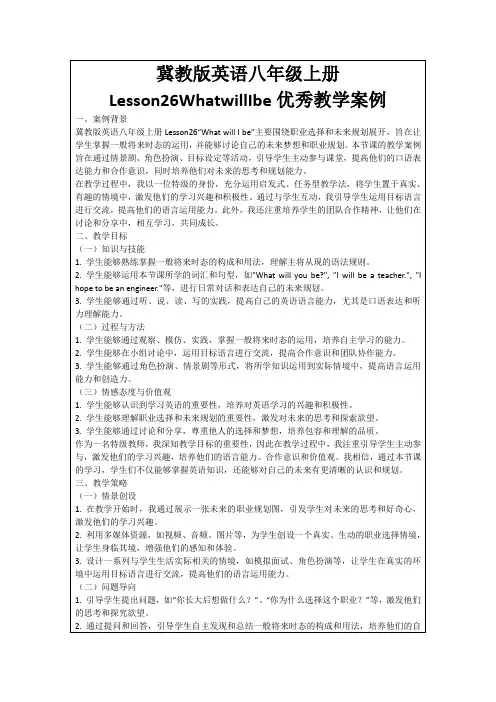
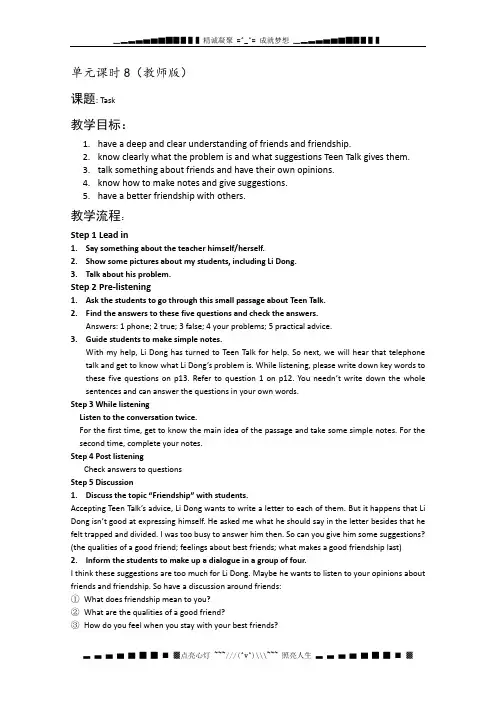
单元课时8(教师版)课题: Task教学目标:1.have a deep and clear understanding of friends and friendship.2.know clearly what the problem is and what suggestions Teen Talk gives them.3.talk something about friends and have their own opinions.4.know how to make notes and give suggestions.5.have a better friendship with others.教学流程:Step 1 Lead in1.Say something about the teacher himself/herself.2.Show some pictures about my students, including Li Dong.3.Talk about his problem.Step 2 Pre-listening1.Ask the students to go through this small passage about Teen Talk.2.Find the answers to these five questions and check the answers.Answers: 1 phone; 2 true; 3 false; 4 your problems; 5 practical advice.3.Guide students to make simple notes.With my help, Li Dong has turned to Teen Talk for help. So next, we will hear that telephone talk and get to know what Li Dong’s problem is. While listening, please write down key words to these five questions on p13. Refer to question 1 on p12. You needn’t write down the whole sentences and can answer the questions in your own words.Step 3 While listeningListen to the conversation twice.For the first time, get to know the main idea of the passage and take some simple notes. For the second time, complete your notes.Step 4 Post listeningCheck answers to questionsStep 5 Discussion1.Discuss the topic “Friendship” with students.Accepting Teen Talk’s advice, Li Dong wants to write a letter to each of them. But it happens that Li Dong isn’t good at expressing himself. He asked me what he should say in the letter besides that he felt trapped and divided. I was too busy to answer him then. So can you give him some suggestions? (the qualities of a good friend; feelings about best friends; what makes a good friendship last)rm the students to make up a dialogue in a group of four.I think these suggestions are too much for Li Dong. Maybe he wants to listen to your opinions about friends and friendship. So have a discussion around friends:①What does friendship mean to you?②What are the qualities of a good friend?③How do you feel when you stay with your best friends?④What makes a good friendship last?⑤Does having friends make you a better person?⑥How do you want your friend to treat you?Choose at least two of the questions to discuss with your partners and make up a dialogue in a group of four.3. Present the ways of expressing “Agreeing” and “Disagreeing”Don’t hurry. Before your own dialogue, let me show you two dialogues made up by my students on the same topic “Staying a teenager forever would be great.” Pay attention to which one is better. Why ? (Because the better one varies the ways of expressing agreeing and disagreeing)4. Students make up their own dialogue.5. Choose three groups to present their dialogueStep 6 Do The task on page 16反馈巩固:Write a letter to your friend and ask your friend to correct your mistakes in your letter. Pay attention to facts, gammar, handwriting, punctuation, vocabulary, spelling and style.教学反思:。
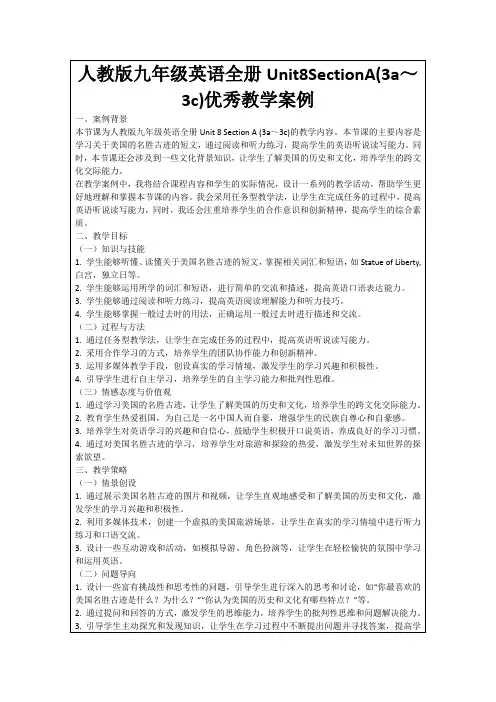
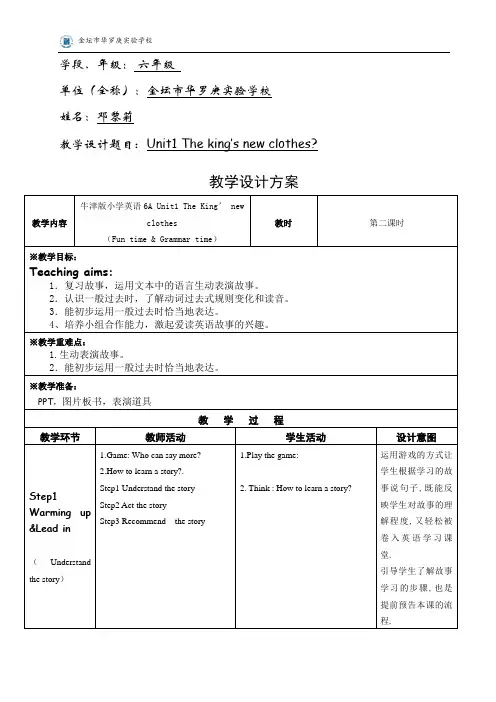
Title: 8B Unit 3 Comic strip and welcome to the unit Teacher: (华罗庚实验学校朱国琴)Teaching aims:1. Knowledge aim(知识目标):(1)To enable students to understand the uses of the computers.(2)Master the usage of “ use…todo/ for”.2. Ability aim(能力目标):(1)To practi ce students’ ability of communicating with others.(2)After learning this lesson, to enable the students to describe the uses of the computers.3. Moral aim(情感目标):(1)To enable the students to use the computer to do something useful and helpful.教学反思:本节课从学生的兴趣、实际出发,符合初中生的心理需求,贴近他们的生活。
对于学生的回答和表述,老师给予肯定和后续性的评价,拉近了师生之间的距离。
学生在知识技能的同时,也享受了用英语交流和被老师肯定的快乐。
通过生生互动,师生互动,学生合作,探索学习,达到本课预定的知识、技能和情感目标。
提高了学生的人文素养,培养了学生终身学习的能力。
同时,本节课也注重多媒体技术和教学内容的结合,做到了课件真正为教学目标服务,大大提高了课堂效率,增加了趣味性。
充分体现了把课堂还给学生的原则。
在教学中体现了听说领先读写跟后的原则,循序渐进,环环相扣。
教学环节流畅自然,内容丰富多彩,课容量大。
注重教学内容和实际生活紧密相连,学以致用,认真引导学生掌握电脑用途并利用电脑辅助于自己日常的生活与学习,达到双赢的效果。
单元课时10(教师版)单元测试一、单项选择1. ---That would mean ________much more money.----Really? I don’t mean _______any more money.A. wasting; wastingB. to waste; to wasteC. wasting; to wasteD. to waste; wasting2. He has some doubt _________he will succeed in his research work.A. thatB. whetherC. whichD. weather3. A middle-aged woman came _______to the bus only ______the bus had gone.A. to run; to findB. running; to findC. and run; foundD. running; finding4. When I opened the door, I found my father sitting in his chair, completely ___________in a magazine.A. absorbedB. gatheredC. losingD. concentrated5. ---How do you deal with the disagreement between the company and the customers?---The key_______ the problem is to meet the demand _______by the customers.A. to solving; makingB. to solving; madeC. to solve; makingD. to solve; made6. Shall we _________ to the manager that the working system be reformed as soon as possible?A. suggestB. adviseC. remindD. persuade7---I thought you didn’t mind---Well, as a matter of fact, I ______, but you _________first.A. didn’t; shouldn’t let me knowB. don’t; should let me knowC. didn’t; should have let me knowD. don’t; should have let me know8._____still happens that some people don’t inform the police of their archaeological discoveries,because they doubt whether their finds are ______ interest and value to archaeology.A. It; ofB. This; ofC. It; withD. That; with9._______at the invention show, the new type of robot is expected to be applied in many fields.A. High valuingB. Highly valuedC. Highly valuingD. Highly valued10. The strong earthquake lasted over ten minutes. ________most of the buildings in the city felldown.A. As a resultB. On the other handC. As a matter of factD. On the contraryKeys: 1-5 CBBAA 6-10 ACABA二、完形I can still remember the first day when I met my best friend. I hid behind my mother and she hid behind her grandmother, __1__to look at each other. But we soon lost the __2__and started playing with each other.In the 7th grade, I first lost touch with her. She was__3__family problems and I deserted her to be with the “cooler people”.__4__of my new friends like her as much as I did __5__they knew she had “problems”. However, every summer we would__6__sit at each other’s house and watch soap operas and talk about everything we liked.It was last year when I__7__the problem. I guessed I was just too busy to catch up in high school to realize she __8__someone there for her. Well, she made a new “best friend”and __9__did I. Then I didn’t know why, but she started cutting herself!She was diagnosed(诊断) with clinical depression(抑郁症) .I was very__10__at first, but with the late night calls, we still stayed in__11__. I wanted to be there for her since her new best friend __12__deserted her, since people were calling her__13__, and I knew I still__14__her like a sister.Yesterday she came __15__me and said this: “I never knew what a best friend was __16__you were the only person that would stop me from cutting; the only person that ever made me feel better about myself and my __17__. You don’t know this but I was trying to kill myself one night when you__18__me and I was crying. I owe you so much, and you didn’t even know you were__19__me.”We both cried. And I guess a kind of lesson from my life so far is to never__20__your friends.1. A. pleased B. excited C. afraid D. disappointed2. A. happiness B. kindness C. shyness D. sadness3. A. working out B. answering for C. helping with D. going through4. A. All B. None C. No D. Every5. A. because B. thought C. while D. yet6. A. sometimes B. seldom C. just D. always7. A. solve B. notice C. faced D. understood8. A. asked B. needed C. had D. left9. A. so B. neither C. either D. nor10. A. mad B. careless C. hopeful D. upset11. A. touch B. bed C. hospital D. love12. A. luckily B. successfully C. basically D. calmly13. A. selfish B. crazy C. brave D. lonely14. A. believed in B. waited for C. cared about D. replied to15. A. with B. after C. upon D. to16. A. until B. when C. since D. if17. A. mistakes B. parents C. friends D. problems18. A. visited B. encouraged C. called D. prevented19. A. helping B. reminding C. cheating D. praising20. A. give up on B. look back at C. drop in at D. look down onKeys: 1-5 CCDBA 6-10DBBAD 11-15 ACBCD 16-20 ADCAA三、阅读理解AThere are good Santas and there are bad Santas. The good Santas all realize one thing: In the mind of a child, Santa Claus is perfect.That’s difficult. And so they come from around the world to attend the Charles W. Howard School in Midland, Mich. The school offers a three-day, 40-hour course for Santas hoping to be excellent. There’s a real range to what Santas earn, from big bucks for large events to no payfor charities(慈善). One thing for them all is pure love for children.A former Macy’s Santa named Charles Howard founded the Michigan school in 1937. “Many people will think if you have a suit and you’re a Santa,” said Tom Valent, the school’s current dean. “It’s more than that.”So with a pet reindeer(驯鹿), his properly named wife Holly and a workshop full of wonder.The school teachers everything from breathing techniques for carol singing(唱圣诞歌) to the beard maintenance(保养). There are lessons in child psychology(心理学), sign language and even media training for talk-show appearances and call-in shows. Santas also need to make sure they know all the names of the reindeer. What’s harder to do with, however, is children who ask for Christmas gifts like bringing daddy home or making mommy happy again.After spending some time in the classroom, Weir went to the test his training. However, at one point, his hat fell off, and he was unsure how to react. “You’re the real Santa,” Valent said. “Pick that hat up, slip it back on, keep smiling and do your job. You’ve got to stay on top of your game. Even the last one at night, when you’re tired, you’ve got to remember: This one’s forever, so do a good job.”1. According to the passage, good Santas should be the one’s that________.A. can offer children some giftsB. help adults look after their childrenC. have ability to make children happyD. are perfect in the mind of children2. The underlined words “big bucks” in the second paragraph refer to____.A. lots of moneyB. many giftsC. loves for childrenD. gifts from children3. The Michigan school was founded by Charles Howard with the purpose to_______.A. train the pet reindeer for SantasB. earn money from its studentsC. train excellent Santa for the worldD. show the world’s concern to the poor4. According to Weir’s performance, we can conclude that ________.A. Weir was short of experienceB. Weir was not fit for the job as a SantaC. Weir did very badly in the gameD. Weir was not a good student in schoolBConsider... YOU. In all time before now and in all time to come, there has never been and will never be anyone like you. You are unique in the entire history and the future of the universe. Wow! Stop and think about that. You are better than anyone in a million, or a billion , or a gazillion.You are the only one in a sea of infinity(无限)!You are amazing! You are awesome(敬畏)!Beautiful young people are the whimsy(随意) of nature, but beautiful old people are true works of art. Howev-er, you don’t become “beautiful” just by virtue of the aging process.Real beauty comes from learning, growing, and loving in the ways of life. That is the Art of Life. You can learn slowly, and sometimes painfully, by just waiting for life to happen to you, or you can choose to accelerate your growth and intentionally destroy life and all its offer. You are the artist that paints your future with brush of today.Paint a masterpiece.God gives every bird its food, but he doesn’t throw it into its nest. Where- ver you want to go, whate ver you want to do, it’s truly up to you!5. Which would be the best title for the passage?A. YouB. A masterpieceC. Enjoy your lifeD. Real beauty6. What does the underlined word “accelerate” mean?A. Slow down.B. Increase the speed of.C. Develop.D. Help.7. What is the main idea of the last three paragraphs?A. God will help those who are most diligent(勤奋的).B. Actions are more important than goals.C. God will help you if necessary.D. You are the master of your goals and actions.Keys: (A)DACA (B)ABD教学反思:。
廖艳平老师设计的“语法课(Unit 1, Module 3 <人教版>”,在2009年我省高中英语优秀教学论文和教学设计评选中,荣获教学设计二等奖。
江小娅老师设计的“听说课(Unit 1, Module 3 <人教版>)”,在2009年我省高中英语优秀教学论文和教学设计评选中,荣获教学设计三等奖。
Module 3 Unit 1 Festivals around the WorldPeriod three: Grammar Modal Verbs惠州市华罗庚中学廖艳平ⅠAnalysis of studentsGrammar of any kind is usually the least interesting topic fo r students. Students haven’t developed the habit of learning inde pendently. Instead, they are used to relying on teachers’ instruc tions a lot.ⅡTeaching material analysisThis teaching period mainly deals with the grammar: modal verbs—— the use of can, could, may, might, will, would, shall, should, must, and can’t. Abstract and boring as the modal verbs are, we s hould try to make students learn them in an easy and effective way.Ⅲ Teaching aims1. Knowledge aims:Get students to grasp the use of the modal verbs, discover the imp lied meanings of modal verbs used in sentences, such as permission, ability, possibility, request, promise, guessing and so on. And g et students to learn to use them in different situations with prop er modal verbs.2. Abilities aims:Cultivate students’ ability to distinguish and discover the sub tle implications that modal verbs carry in sentences and develop s tudents’ communicative ability by learning the use of modal verbs for making requests, giving advice, asking for permission, and so on.3. Emotional aims:Develop students’ teamwork spirit and inspire students to be inte rested in grammar learning.ⅣTeaching key points and difficult points1. Teaching key pointsGet students to learn and master the use of the modal verbs in dis covering and practice, and enable students to learn how to use the m correctly in different contexts.2. Teaching difficult pointsGrammar rules are hard to remember, and grammar is a dull subject that some students are unwilling to learn it by heart.Ⅴ Teaching and learning methodsTask-based Instruction, Audio-visual Teaching MethodCooperative Learning and Active Exploration MethodUnder the guidance of learning by use it, make students thoroughly master the use of modal verbs in class while the teacher acts as a guide and director, leading students to learn grammar through al l kinds of activities and situations and make dialogues in pairs. Ⅵ Teaching aidsMulti-media computer, PPT, Blackboard, etc.Ⅶ The time table of teaching procedures1. Revision and lead-in(5 minutes)2. Presentation and discovering (8 minut es)3. Practice (14 minutes)4. Production(12 mi nutes)5. Homework (1 minut e)Ⅷ Teaching proceduresStep 1 Revision and lead-in1. Check up students’ homework of the exercises on page 4.2. Let students listen to a song, I Want To Be With You, which con tains many modal verbs. Ask students to fill in the missing words in the lyrics.The lyrics are given in Appendix 1.3. Show some pictures to create certain contexts for students to r eview modal verbs. These sentences will activate students’ knowle dge about modal verbs.Purpose: Bring up the topic of this period, modal verbs, and revie w related knowledge about them.Step 2 Presentation and discovering1. Give out each student a sheet in which many sentences with moda l verbs are listed. Ask students to discuss in groups of four to w ork out how each of these modal verbs is being used in the situati ons. Tick the right answers.The sentences are given in Appendix 2.Purpose: Introduce the usage of the modal verbs.2. A table will be shown to the students. Ask students to use the function words to explain the meaning of the modal verbs.Please refer to Appendix 3 for the table.Purpose: Improve students’ ability to generalize.Step 3 PracticeActivity 1Do Exercise 2 on page 5. Students can discuss the answers with the ir partners.Purpose: Make students proficient in doing exercise with what they have learnt in the last step.Activity 2Present several pictures related to festivals around the world and let students complete the sentences according to the pictures wit h proper modal verbs.Purpose: Help students review some information about festivals aro und the world and cultivate the awareness of employing modal verbs in language production.Activity 3More exercises concerning modal verbs will be shown on the screen. The exercises are given in Appendix 3.Purpose: Check students’ understanding of modal verbs.Step 4 ProductionStudents will be encouraged to make dialogues based on each of the given situations, using modal verbs. Practise in pairs and presen t the dialogue in class.1. You want to invite your for eign friend to come China to spend the spring festival.2. You want to ask your mum fo r permission to go with your friends to the cinema.Purpose: Help students apply modal verbs to real situations and im prove their oral English skills.Step 5 Homework1. Finish off the Workbook exercises on P43.2. Create five sentences by using some of the modal verbs. Purpose: Consolidate their knowledge about modal verbs and practis e this grammar comprehensively.Teaching assessment1. In this lesson, I’ve learned__________.2. After the lesson I still have difficulty in _________ __.3. I feel ________ with my class performance.A. very satisfiedB. satisfiedC. a little satisfiedD. not satisfied at all4. I find I need to work harder in the following areas:A. learn before the lessonB. vocabularyC. writing abilityD. confidence buildingE. working with othersAppendix 1I Want To Be With YouThere are things that must be doneThat are not yet begunThings that I must doWhen I want to be with youAlthough we might be far apartYou should be with me in my heartNo one else will doI just want to be with youI want to be with youCan’t you hear me?I need you near meI want to be with youI need you near me, my love The two of usmust be oneMother of my sonNo one else will doI just want to be with youI want to be with youCan you hear me?I need you near meI want to be with youI need you near me, my loveAppendix 21. She can sing that song in English. (ability / possibi lity)2. I could not understand the lecture on the computer gi ven by Mr. Smith. (ability / guessing)3. You can borrow this useful book from the library. (po ssibility / permission)4. Can I ask you some questions about it? (advice / perm ission)5. She couldn’t/can’t be so stupid to do that. (reques t / guessing)6. Could you speak a little slowly? (euphemistic / past habit)7. I may be busy from tomorrow on. (ability / possibilit y)8. May I come in? (permission / guessing)9. Students must work hard at their study. (advice / per mission)10. You must be tired after working so long. (guessing / predict ion)11. It must have rained last night for it is so wet outside. (gu essing / past habit)12. We should read English aloud every morning. (advice / agreem ent)13. This book should be published in two month at most. (predict ion / possibility)14. Would you tell me how to get to the shopping center? (guessi ng / request)15. He would sit there for hours, doing nothing at all. (past ha bit / ability)Appendix 3Appendix 41. — ____ I go out to play, mum?— No, you___. You should do your homework first.A. Might; wouldn’tB. May; had better notC. Must; mustn’tD. Need; mustn’t2. —The room is in a terrible mess; it ____ cleaned.A. can’t have beenB. couldn’t beC. may have beenD. would be3. —Jane has just come back from China and she looks happy.—She _________ her trip very much.A.must enjoyB. must have enjoyedC. may enjoy D should have enjoyed4. —When can I come for the photos? I need them tomorrow afternoo n.—They _____ be ready by 12:00.A. canB. shouldC. mightD. needModule 3 Unit1 Festivals around the worldPeriod 4 Listening & Speakimg华罗庚中学江小娅Ⅰ The analysis of the studentsStudents in our school aged from fifteen to seventeen with differe nt levels. They have the basic ability of listening and speaking. However, some of them come from the countryside and most of the st udents are poor in listening and speaking, especially spoken Engli sh. They seem to like the teacher-centered classroom and less acti ve in the English class. This period places emphasis on developing students’ listening and speaking ability. We should try our best to encourage students to say something. Don’t always correct the mistakes they have made while they are speaking. Otherwise, they w ould feel reluctant and not say anything more.ⅡTeaching material analysis:The position and function of the teaching materialThis is the fourth teaching period of this unit. We will mainly de al with listening and speaking in this period. At the beginning, s tudents listen to a conversation among young people. This listenin g activity is not only to offer students knowledge about how to ce lebrate Carnival in Trinidad but to encourage students to listen a nd then use what they have heard to help them answer questions. It is an important exercise because it links skills together and use s them to produce a useful phone call. The speaking exercise is intended to give students the opportunity to practice a phone conver sation using the functional items.Combined with the analysis above and English Curriculum Criteria, the Teaching Aims of this lesson would be set as the following thr ee types:Ⅲ Teaching goals:1. Target language:1. Get students to learn some useful new words and expressions in the listening passage.2. Let students learn the expressions to make phone calls, give in vitations and show thanks.2. Ability goals:1. Enable students to catch and understand the listening material s.2. Develop students’ ability to get special information and take notes while listening.3. Get students to learn and use the expressions of making phone c alls, invitations and thanks.3. Emotion & attitude goals:1. Enable students to know more about festivals and love their lif e.2. Develop students’ sense of group cooperation and teamwork.ⅣTeaching difficult and important points1. Get students to listen to and understand listening materials wi th various English accents.2. Let students learn how to make phone calls and invitations and express thanks.3. Develop students’ listening and speaking abilities.ⅤTeaching & learning strategies:1. Audio-visual teaching method2. Task-based approach3. Independent Learning4. Co-operative learningIn the whole process of teaching, teacher is only a guide, leading students to listen and speak, and arouse their interests. Student s would listen by themselves and cooperate with their classmates, teachers would offer some help if necessary.Ⅵ Teaching aidsPPT, Multi-media computer, Blackboard and so on.Ⅶ Teaching proceduresThe time table of step sections:Revision (2minutes)Warming up (3minutes)Listening (15minutes)Speaking (15minutes)Question time (3minutes)Summary and Homework Assignment (2minutes)Step1 RevisionCheck the modal exercises on workbook.Purposes: Review what we have learned in the last period.Step 2 Warming upAsk students to look at the pictures of the Trinidad Carnival and discuss in pairs what kind of activities the Carnival might have. Purpose: To review what they learned in the last lesson and activa te students to practise their oral-English. And also arouse stud ents' interests, preparing for the listening.Step 3 listeningTask 1 First listeningGet students to listen to the whole passage and try to find “what are they talking about?”.Purpose: This step is to train the students listening skill to get a general grasp of the conversation.Task 2 Second listening: Part 1Lead students to go through the two questions and ask them to make some notes while listening.1.What is the advice that Carla gives Li Mei?2.What do they find when they arrive at the park?Finish T/F questions.Task 3 Third listening: Part 2Get students to listen to Part Two of the listening tape, then ask them to make notes of the following questions.3.Why is it important for them to have water?4.Why can’t they hear each other?5.Why do they plan to meet at the parking lot?Finish the multiple-choices.Purpose: These two steps are to help students focus on the importa nt points while listening and form the habit of making notes. Task 4 Fourth listening1) Get the students to listen to the two parts again and finish th eir answers.2) Discuss with partners and check the answers.Task 5 Retell the materialGive students the text of the listening passage and ask them to fi ll in the blanks.Purpose: To get students to have a better understanding of the lis tening material.Step 4 SpeakingTask 1 Pre-speakingAsk the students to give some expressions of making phone calls, i nvitations and thanks according to the knowledge they learned befo re.Purpose: This design is to activate what the students have learnt before to get ready for the next task-speaking.Task 2 Sample dialogueShow students a sample dialogue and ask them to pay attention to t he useful expressions.Purpose: Guide students to make a conversation.Task 3 Role-interactive1. Imitate the sample dialogue to make your own conversationAsk the students to think over the task: Imagine you have just vis ited your friends in Trinidad and seen the Carnival. Make a phonecall to invite your friends to a Chinese festival. In pairs make a conversation of at least five turns each.2. Get several representatives to act out their conversations then ask the whole class to select the best one.Purpose: Act-out would be the teaching and learning activities to train the students’ speaking skills and build their interests in learning English.Step 5 Questions timeAsk students to check if they have any questions and they can ask freely.Purpose: This step is to know the students’ understanding of this period and help them to overcome the difficulties.Step 6 Summary and Homework Assignment1. Finish the listening task on P45.2. Preview the passage A Sad Love Story.Step 7 Teaching assessment1. In this lesson, I’ve learned .2. I have difficulty in.. .。